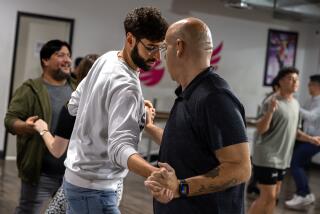Liz Casebolt and Joel Smith plan more unorthodox dance moves
In 2010, Liz Casebolt and Joel Smith sold out multiple shows in a 200-seat theater at the Minnesota Fringe Festival. The local press crowned the Los Angeles-based choreographic duo a hot ticket item, and one critic noted that the crowd flocking to see them “were people who ordinarily might not attend a dance performance.”
That experience had Casebolt and Smith pondering just how broad of an audience they could attract. Since forming their eponymous company in 2006, they had been steadily honing their particular brand of comic, talky and vaudevillian dance-theater in which they subject their gay man-straight woman friendship, creative process and the tropes of contemporary dance to microscopic scrutiny.
Over the years, they have found success mostly outside of Los Angeles, in festivals and venues dedicated to emerging artists where they have stood out to audiences and critics. A 2010 performance at the New York City-based Joyce SoHo, for example, garnered them a review in the New Yorker, which described them as “clever, sometimes silly and not afraid to talk as much as they dance.”
“What people respond to in our work is the reveal of our neuroses and process of working,” Smith says. “We also don’t take ourselves too seriously, but when people see our work, I think they realize that we’re serious about our craft and that we have a clear idea of what we want to achieve.”
Determined to perform in their own city and inspired by the theater-oriented crowd they drew in Minnesota, the duo decided to challenge one of the biggest conventions attached to presenting contemporary dance in Los Angeles: the one- to two-weekend performance run, which has been the norm for local and visiting companies, from the emerging to the internationally renowned. Convinced this model would not serve them in furthering their careers, Casebolt, 43, and Smith, 34, will instead embark on a self-produced six-week run of their work “O(h)” beginning Friday at the Actors Company Theatre in West Hollywood.
“We aren’t the kind of artists who are just going to sit around and wait to be presented,” says Smith, noting the venues that present dance in Los Angeles can “be counted on one hand. We want to make things happen in our home city and we’re viewing this as a research opportunity. We’re either going to learn or not learn how to fill 70 seats every weekend for six weeks.”
In “O(h),” Casebolt and Smith mine material largely dependent on acute comic timing as they spend about an hour dancing, singing and conversing about what they do and don’t do as a dance-theater duo. Having successfully performed the show in other cities, they hope it can expand their audience in Los Angeles, attract greater media coverage and essentially help them transcend the limited performance opportunities, funding and recognition that are frequently the lot of emerging dance artists. They have raised almost $20,000, hired a publicist who’s marketing their show as both theater and dance, and collaborated with architects Hadrian Predock and John Frane on a futuristic set design with the goal of transforming their rented black box theater into a uniquely atmospheric interior.
Dance artists attempting a six-week run is unusual, says Cathy Eilers, who in her role as program manager for Joyce SoHo combs through hundreds of submissions from dance companies across the country seeking a spot in her venue’s performance seasons. “And that’s unfortunate because extended runs can help dance companies build their audience and media presence.”
The main Joyce Theater (which presents more established dance artists than the Joyce SoHo) presents popular companies such as Pilobolus or Momix for three- to four-week runs while the largest of New York companies, including New York City Ballet and Alvin Ailey, generally have extended runs.
“But it is extremely rare for a less-established, emerging and/or a younger company to have more than a two- to four-show run in New York,” Eilers says. “When I heard that Casebolt and Smith were doing this, I thought, ‘Holy cow!’ But I think they’re really dynamic and funny, and they have an amazing chemistry, which isn’t something I see every day.”
Banking perhaps on that chemistry, Casebolt and Smith have taken the additional risk of pricing their show at $30 a ticket. This makes seeing their work a more expensive proposition than attending performances at the two main venues in Los Angeles that present experimental dance-theater, REDCAT or Highways, where tickets are commonly priced at $20.
“There will be people who will say, ‘I’m not paying $30,’ and that’s exactly what we’re addressing. It’s not that people can’t afford it, it’s that there’s a stigma attached to this kind of dance-theater and we’re saying we value the work we do as artists,” Smith says.
Sitting on their rented stage at the Actors Company Theatre complex, Casebolt and Smith are focused yet relaxed after a day of rehearsing and meeting with their production team. Unlike some close collaborators who finish each other’s sentences, they take care to let the other speak, though Smith does the majority of the talking.
“Joel’s much more goal- and task-oriented while I tend to be more laid back,” says Casebolt, a dance professor at Los Angeles Valley College. “But I think a big reason why we work so well together is that we’re best friends first. We wouldn’t have our work if we didn’t have our friendship.”
The two, both of whom received graduate degrees in experimental choreography from UC Riverside, met during an audition in 2004 for choreographer Hassan Christopher’s Company of Strangers. Smith thought that Casebolt “was the most beautiful dancer in the room” and Casebolt, watching Smith audition, “felt here was someone doing something different than what I expected to see.”
“We share the same sense of humor and a similar aesthetic of what we appreciate in performance,” says Smith, a former competitive swimmer who didn’t start dancing until he was 20 and teaches at UC Riverside, UCLA and Scripps College. “We attend a lot of dance together, and we usually love the same thing or hate the same thing.”
In “O(h),” Casebolt and Smith spend a good chunk of time on this particular subject. During their earlier rehearsal, they ran a section where they give a lecture/demonstration on “what we don’t do” as a dance-theater duo. This included “creating audible breath to create the sound score, running in repetitive circles to suggest time passing and evolution” and riffing on the cliché of the big strong man (Smith is tall, built and darkly handsome) lifting the smaller, pretty woman (Casebolt is not as tall, blond and fair-skinned) so that “she can show off her crotch.”
“I love working with them,” says Heather Libonati, the show’s lighting designer. “I’ve seen the exact things that they’re making fun of. They really make me laugh.”
But like all ambitious provocateurs, Casebolt and Smith hope people see beyond the entertainment factor in their work. “We talk a lot about the confusion people have with dance. This ‘Am I supposed to get what this movement or gesture means? Is it about love, is it about cancer?’ We’re just trying to open up the conversation about this,” Smith says.
Ultimately, Casebolt and Smith believe that their penchant for mocking their medium stems from their passion for it. “As much as we’re poking fun of dance, we also love what we do and we value what other people in the dance world do,” Smith says. “And it’s important that dance in L.A. keeps evolving. I just wish we could stop talking about how hard it is to create dance in this city.”
More to Read
The biggest entertainment stories
Get our big stories about Hollywood, film, television, music, arts, culture and more right in your inbox as soon as they publish.
You may occasionally receive promotional content from the Los Angeles Times.






